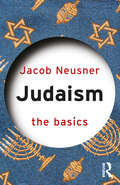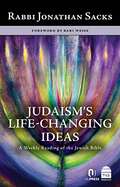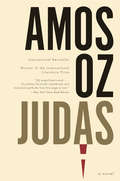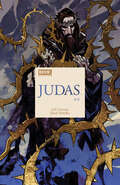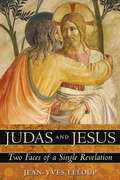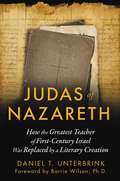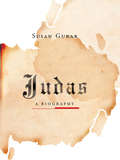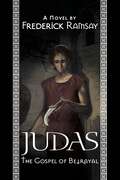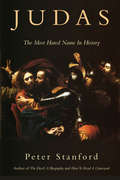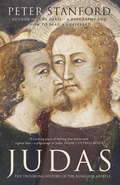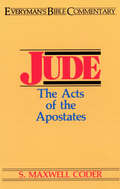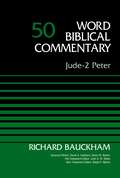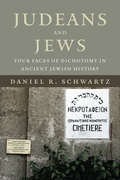- Table View
- List View
Judaism: History, Belief and Practice
by Dan Cohn-SherbokThis newly revised all-encompassing textbook is a guide to the history, beliefs and practice of Judaism. Beginning with the ancient Near Eastern background, it covers early Israelite history, the emergence of classical rabbinic literature and the rise of medieval Judaism in Islamic and Christian lands. It also includes the early modern period and the development of Jewry in the nineteenth and twentieth centuries. Extracts from primary sources are used throughout to enliven the narrative and provide concrete examples of the rich variety of Jewish civilization. Specially designed to assist learning, Judaism: • Introduces texts and commentaries, including the Hebrew Bible, rabbinic texts, mystical literature, Jewish philosophy and Jewish theology • Provides the skills necessary to understand these step-by-step with the help of a companion website • Explains how to interpret the major events in nearly four thousand years of Jewish history • Supports study with discussion questions on the central historical and religious issues, and includes key reading for each chapter, an extensive glossary and index • Illustrates the development of Judaism, its concepts, observances and culture, with maps, photos, paintings and engravings • Links each chapter to a free companion website at www.routledge.com/cw/cohnsherbok which provides things to think about, things to do and tips for teachers as well as other online resources
Judaism: The Basics (The Basics)
by Jacob NeusnerThe oldest of the world’s major faiths, Judaism as practiced today represents a tradition that goes back nearly 6,000 years. Accessible and wide-ranging, Judaism: The Basics is a must-have resource covering the stories, beliefs and expressions of that tradition. Key topics covered include: the Torah Israel – the state and its people Passover Reform Judaism, Orthodox Judaism and Zionism the impact of the Holocaust. With a glossary of terms and extensive suggestions for further reading, Judaism: The Basics is an essential guide through the rich intricacies of the Jewish faith and people.
Judaism: The Genealogy of a Modern Notion (Key Words in Jewish Studies #35)
by Daniel BoyarinJudaism makes the bold argument that the very concept of a religion of ‘Judaism’ is an invention of the Christian church. The intellectual journey of world-renowned Talmud scholar Daniel Boyarin, this book will change the study of “Judaism”—an essential key word in Jewish Studies—as we understand it today. Boyarin argues that although the world treats the word “Judaism” as appropriate for naming an alleged religion of the Jews, it is in fact a Christian theological concept only adopted by Jews with the coming of modernity and the adoption of Christian languages.
Judaisms: A Twenty-First-Century Introduction to Jews and Jewish Identities
by Aaron J. Hahn TapperWhat does it mean to be a Jew in the twenty-first century? Exploring the multifaceted and intensely complicated characteristics of this age-old, ever-changing community, Judaisms examines how Jews are a culture, ethnicity, nation, nationality, race, religion, and more. With each chapter revolving around a single theme (Narratives, Sinais, Zions, Messiahs, Laws, Mysticisms, Cultures, Movements, Genocides, Powers, Borders, and Futures) this introductory textbook interrogates and broadens readers' understandings of Jewish communities. Written for a new mode of teaching--one that recognizes the core role that identity formation plays in our lives--this book weaves together alternative and marginalized voices to illustrate how Jews have always been in the process of reshaping their customs, practices, and beliefs. Judaisms is the first book to assess and summarize Jewish history from the time of the Hebrew Bible through today using multiple perspectives. Ideal for classroom use, Judaismsprovides a synthetic and coherent alternative understanding of Jewish identity for students of all backgrounds;focuses on both the history of and potential futures for physical and ideological survival;includes an array of engaging images, many in color;offers extensive online resources including notes, key terms, a timeline of major texts, and chapter-by-chapter activities for teaching.
Judaism’s Life-Changing Ideas: A Weekly Reading of the Jewish Bible
by Rabbi Jonathan SacksWhat is Judaism? A religion? A faith? A way of life? A set of beliefs? A collection of commands? A culture? A civilization? It is all these, but it is emphatically something more. It is a way of thinking about life, a constellation of ideas. One might think that the ideas Judaism introduced into the world have become part of the common intellectual heritage of humankind, at least of the West. Yet this is not the case. Some of them have been lost over time; others the West never fully understood. Yet these ideas remain as important as ever before, and perhaps even more so. In this inspiring work, Rabbi Sacks introduces his readers to one Life-Changing Idea from each of the weekly parashot.
Judaizing Christianity and Christian Zionism in Northern Ireland: For God, Israel, and Ulster (Routledge Studies in Religion)
by Véronique AltglasThis book explores the contemporary Judaization of evangelical Christianity through the ethnography of a Messianic congregation in Northern Ireland. A constellation of Messianic "congregations" have expanded worldwide over recent years, combining Jewish liturgy, symbols, and artifacts with prophecies about the End Times and the return of Jesus. Increasingly recognized as a legitimate subdivision within evangelicalism, the Messianic movement has facilitated a popularization of Jewish practices and symbolism beyond its own congregations. The author considers: What insights do these congregations offer about the deregulation of religions? Is there any logic to the combinations of Christian and Jewish sources in Messianic beliefs and practices? How can we understand this fascination with Jews and Judaism? Finally, what is the political significance of Messianic relationship with Jewish people, the state of Israel, and Christian Zionism? The book will be of particular interest to scholars of the sociology and anthropology of religion, religion and politics, and Jewish-Christian relations.
Judas
by Nicholas De Lange Amos OzWinner of the International Literature Prize, the new novel by Amos Oz is his first full-length work since the best-selling A Tale of Love and Darkness. Jerusalem, 1959. Shmuel Ash, a biblical scholar, is adrift in his young life when he finds work as a caregiver for a brilliant but cantankerous old man named Gershom Wald. There is, however, a third, mysterious presence in his new home. Atalia Abarbanel, the daughter of a deceased Zionist leader, a beautiful woman in her forties, entrances young Shmuel even as she keeps him at a distance. Piece by piece, the old Jerusalem stone house, haunted by tragic history and now home to the three misfits and their intricate relationship, reveals its secrets. At once an exquisite love story and coming-of-age novel, an allegory for the state of Israel and for the biblical tale from which it draws its title, Judas is Amos Oz's most powerful novel in decades.
Judas
by Amos OzInternational Bestseller Winner of the International Literature Prize Finalist for the Man Booker International Prize A New York Times Editors’ Choice “[A] magnificent novel . . . Oz pitches the book’s heartbreak and humanism perfectly from first page to last.” — New York Times Book Review “Scintillating . . . An old-fashioned novel of ideas that is strikingly and compellingly modern.” — Observer Jerusalem, 1959. Shmuel Ash, a biblical scholar, is adrift in his young life when he finds work as a caregiver for a brilliant but cantankerous old man named Gershom Wald. There is, however, a third, mysterious presence in his new home. Atalia Abravanel, the daughter of a deceased Zionist leader, a beautiful woman in her forties, entrances young Shmuel even as she keeps him at a distance. Piece by piece, the old Jerusalem stone house, haunted by tragic history and now home to the three misfits and their intricate relationship, reveals its secrets. At once an exquisite love story and a coming-of-age novel, an allegory for the state of Israel and for the biblical tale from which it draws its title, Judas is Amos Oz’s most powerful novel in decades. “Oz has written one of the most triumphant novels of his career.” — Forward “A [big] beautiful novel . . . Funny, wise, and provoking.” — Times (UK)
Judas
by Marvin MeyerJudas Iscariot has been demonized as the quintessential traitor, the disciple who betrayed his master for the infamous thirty pieces of silver. But the recent sensational discovery and publication of the long lost Gospel of Judas, with its remarkable portrayal of Judas Iscariot as the disciple closest to Jesus, raises serious new questions. Was Judas the only member of the Twelve who truly understood Jesus? Did Jesus secretly collaborate with Judas to set in motion the series of events that would redeem all of humankind? In search of answers, Marvin Meyer, one of the world's leading experts on the Gospel of Judas presents a collection of the earliest accounts of Judas, which together paint a fuller portrait of this most enigmatic disciple. This book presents the essential texts that deal with the figure of Judas, including New Testament writings, Gnostic documents, and other early and later Christian literature. These are the earliest known testimonies about Judas and include selections from the gospels of Mark, Matthew, Luke, and John, the Acts of the Apostles, and relevant passages from Paul. The centerpiece of the book is the Gospel of Judas, followed by excerpts from three other Gnostic texts--the Dialogue of the Savior, the Concept of Our Great Power, and the "Round Dance of the Cross"--which may shed new light on the figure of Judas. A series of additional writings on Judas produced over the centuries provide glimpses of the vilification of Judas and the emergence of anti-Semitic themes. Meyer offers evidence of traitors before Judas--the Genesis story of Joseph's brothers who sold him into slavery, the duplicitous friend of the poet in Psalm 41, and Melanthius the goatherd in Homer's Odyssey--all of which raise the question of whether the story of Judas Iscariot could be simply a piece of religious fiction derived from earlier stories. Judas provides a rich collection of original sources that tell the story of Christianity's most infamous figure, offering the fullest understanding of Judas Iscariot's undeniable importance in the climax of Jesus's life.
Judas
by Marvin W. MeyerJudas Iscariot has been demonized as the quintessential traitor, the disciple who betrayed his master for the infamous thirty pieces of silver. But the recent sensational discovery and publication of the long lost Gospel of Judas, with its remarkable portrayal of Judas Iscariot as the disciple closest to Jesus, raises serious new questions. Was Judas the only member of the Twelve who truly understood Jesus? Did Jesus secretly collaborate with Judas to set in motion the series of events that would redeem all of humankind? In search of answers, Marvin Meyer, one of the world's leading experts on the Gospel of Judas presents a collection of the earliest accounts of Judas, which together paint a fuller portrait of this most enigmatic disciple.This book presents the essential texts that deal with the figure of Judas, including New Testament writings, Gnostic documents, and other early and later Christian literature. These are the earliest known testimonies about Judas and include selections from the gospels of Mark, Matthew, Luke, and John, the Acts of the Apostles, and relevant passages from Paul. The centerpiece of the book is the Gospel of Judas, followed by excerpts from three other Gnostic texts--the Dialogue of the Savior, the Concept of Our Great Power, and the "Round Dance of the Cross"--which may shed new light on the figure of Judas. A series of additional writings on Judas produced over the centuries provide glimpses of the vilification of Judas and the emergence of anti-Semitic themes.Meyer offers evidence of traitors before Judas--the Genesis story of Joseph's brothers who sold him into slavery, the duplicitous friend of the poet in Psalm 41, and Melanthius the goatherd in Homer's Odyssey--all of which raise the question of whether the story of Judas Iscariot could be simply a piece of religious fiction derived from earlier stories. Judas provides a rich collection of original sources that tell the story of Christianity's most infamous figure, offering the fullest understanding of Judas Iscariot's undeniable importance in the climax of Jesus's life.
Judas #3 (Judas #3)
by Jeff LovenessJudas confronts Jesus in the pits of Hell, with amazing art by Jakob Rebelka!
Judas #4 (Judas #4)
by Jeff LovenessWith the fate of all of life and the afterlife hanging in the balance, Judas performs an intervention on Jesus in the pits of Hell.
Judas and Jesus: Two Faces of a Single Revelation
by Jean-Yves LeloupA radical reinterpretation of the relationship of Judas and Jesus • Reexamines the role and the purpose the key figure of Judas played in the crucifixion story • Reveals how Judas was “betrayed” by Jesus, and how, taken to the limits of his humanity, he lost everything he most cherished on the path to his true self The familiar story of Judas, betrayer of Jesus, is striking because of its incomprehensibility. Why would one of Christ’s disciples and companions of the heart deliver him up to his enemies and a barbarous, ignominious, and certain death for thirty pieces of silver? Jean-Yves Leloup’s careful investigation of the gospels, various apocryphal texts, and most importantly the Coptic codex known as the Gospel of Judas, leads him to conclude that there is more to the familiar story of Judas than a simple demonstration, viewed through one man, of humanity’s inherent failings. The betrayal of Jesus to the Romans was Jesus’s idea, explains Leloup. Jesus persuaded Judas to play the role of “evil” in humankind by telling him that this enactment was crucial to God’s plan and would set Judas by Jesus’s side for eternity: “There where I am,” spoke Jesus to Judas, “is where I wish you, too, to be.” But to get there, Judas--a metaphorical representation of the darker side present in all human beings and the “shadow” counterpart to his Messiah dying on the cross-- must first shed all his human qualities. His failings of greed, deceit, and cowardice--and even his faith and hope--are washed away in the despair that engulfs him. A parallel moment occurs for Jesus on the cross, when he comes to know the despair of separation from God. The moment Judas “loses” his life and all that gave it meaning--his God, his law, his justice, his Messiah--is the very moment he finds that which cannot be discarded--life eternal. Thus, in the moment of his ultimate extremity, Judas receives Jesus’s true message and his intended gift.
Judas of Nazareth: How the Greatest Teacher of First-Century Israel Was Replaced by a Literary Creation
by Barrie Wilson Daniel T. UnterbrinkAn investigation into the historical Jesus and the veracity of the Gospels • Reveals the biblical Jesus as a composite figure, a blend of the political revolutionary Judas the Galilean and Paul’s divine-human Christ figure • Matches the events depicted in the New Testament with historically verifiable events in Josephus’ history, pushing Jesus’ life back more than a decade • Demonstrates how each New Testament Gospel is dependent upon Paul’s mythologized Christ theology, designed to promote Paul’s Christianity and serve the interests of the fledgling Gentile Christian communities Scholars have spent years questioning aspects of the historical Jesus. How can we know what Jesus said and did when Jesus himself wrote nothing? Can we trust the Gospels, written by unknown authors 40 to 70 years after Jesus’ death? And why do other sources from the time not speak of this messianic figure known as Christ? Drawing on the histories of Josephus, Tacitus, Suetonius, and Pliny as well as the Dead Sea Scrolls, Daniel Unterbrink contends that the “Jesus” of the Bible was actually a composite figure, a clever blend of the Jewish freedom-fighter Judas the Galilean and Paul’s divine-human Christ figure created in the middle of the first century CE. Revealing why Paul was known as a liar, enemy, and traitor in other Jewish literature, he shows that the New Testament Gospels are not transcripts of actual history but creative works of historical fiction designed to promote Paul’s Christianity and serve the interests of the fledgling Gentile Christian communities. He demonstrates how each Gospel is written in light of the success of Paul’s religion and dependent upon his later perspective. Matching the events depicted in the New Testament with the historically verifiable events in Josephus’ history, Unterbrink pushes the dating of Jesus’ life back nearly a generation to a revolutionary time in ancient Judea. He shows that the real historical Jesus--the physical man behind the fictional stories in Paul’s Gospels--was Judas the Galilean: a messianic pretender and Torah-observant revolutionary bent on overthrowing the Roman government and galvanizing the Jewish people behind his vision of the coming Kingdom of God. In the greatest cover-up of history, this teacher of first-century Israel was replaced by the literary creation known as Jesus of Nazareth.
Judas: A Biography
by Susan Gubar"Judas is a dark journey through the murderousness of Christian Anti-Semitism, culminating in the mass slaughter of more than a and their associated European butchers. Lucid, study is close to definitive on the fictive figure of Judas."--Harold Bloom
Judas: The Gospel of Betrayal (Jerusalem Mysteries)
by Frederick RamsayThe child Judas, illegitimate offspring of a Jewish woman and a Roman soldier, struggles to understand his mother's god, a god who allows terrible things to happen to him and his family. Despairing, he becomes a survivor in the brutal streets of the first century Roman Empire.Later, as a young man determined to avenge the wrongs committed against his family, he joins the rebels led by Barabbas, only to be betrayed by them as well. Beaten and broken, he is brought to the community of Zealots at Qumran and eventually to the one forming around Rabbi Jesus. But his enthusiasm for revolution leads him to make a difficult and—for him and others—fateful choice.
Judas: The Most Hated Name In History
by Peter StanfordIn this fascinating historical and cultural biography, Peter Stanford deconstructs that most vilified of Bible characters: Judas Iscariot, who famously betrayed Jesus with a kiss. Beginning with the gospel accounts, Stanford explores two thousand years of cultural and theological history to investigate how the very name Judas came to be synonymous with betrayal and, ultimately, human evil. But as the author points out, there has long been a counter-current of thought that suggests that Judas might in fact have been victim of a terrible injustice: central to Jesus' mission was his death and resurrection, and for there to have been a death, there had to be a betrayal. This thankless role fell to Judas; should we in fact be grateful to him for his role in the divine drama of salvation? "You'll have to decide," as Bob Dylan sang in the sixties, "Whether Judas Iscariot had God on his side." An essential but doomed character in the Passion narrative, and thus the entire story of Christianity, Judas and the betrayal he symbolizes continue to play out in much larger cultural histories, speaking as he does to our deepest fears about friendship, betrayal, and the problem of evil. Judas: the ultimate traitor, or the ultimate scapegoat? This is a compelling portrait of Christianity's most troubling and mysterious character.
Judas: The troubling history of the renegade apostle
by Peter StanfordIn this fascinating historical and cultural biography, writer and broadcaster Peter Stanford deconstructs that most vilified of Bible characters: Judas Iscariot, who famously betrayed Jesus with a kiss. Beginning with the gospel accounts, Peter explores two thousand years of cultural and theological history to investigate how the very name Judas came to be synonymous with betrayal and, ultimately, human evil. But as Peter points out, there has long been a counter-current of thought that suggests that Judas might in fact have been victim of a terrible injustice: central to Jesus' mission was his death and resurrection, and for there to have been a death, there had to be a betrayal. This thankless role fell to Judas; should we in fact be grateful to him for his role in the divine drama of salvation? 'You'll have to decide,' as Bob Dylan sang in the sixties, 'Whether Judas Iscariot had God on his side'.An essential but doomed character in the Passion narrative, and thus the entire story of Christianity, Judas and the betrayal he symbolises continue to play out in much larger cultural histories, speaking as he does to our deepest fears about friendship, betrayal and the problem of evil. Judas: the ultimate traitor, or the ultimate scapegoat? This is a compelling portrait of Christianity's most troubling and mysterious character.
Judas: The troubling history of the renegade apostle
by Peter StanfordIn this fascinating historical and cultural biography, writer and broadcaster Peter Stanford deconstructs that most vilified of Bible characters: Judas Iscariot, who famously betrayed Jesus with a kiss. Beginning with the gospel accounts, Peter explores two thousand years of cultural and theological history to investigate how the very name Judas came to be synonymous with betrayal and, ultimately, human evil. But as Peter points out, there has long been a counter-current of thought that suggests that Judas might in fact have been victim of a terrible injustice: central to Jesus' mission was his death and resurrection, and for there to have been a death, there had to be a betrayal. This thankless role fell to Judas; should we in fact be grateful to him for his role in the divine drama of salvation? 'You'll have to decide,' as Bob Dylan sang in the sixties, 'Whether Judas Iscariot had God on his side'.An essential but doomed character in the Passion narrative, and thus the entire story of Christianity, Judas and the betrayal he symbolises continue to play out in much larger cultural histories, speaking as he does to our deepest fears about friendship, betrayal and the problem of evil. Judas: the ultimate traitor, or the ultimate scapegoat? This is a compelling portrait of Christianity's most troubling and mysterious character.
Jude
by Jeff NesbitJude Asher first called on outside forces to change his destiny as a child. Now a wealthy entrepreneur with his star soaring, he's prepared to make his most daring bet ever to reach the pinnacle of earthly power. Jude's twin brother, Thomas, has chosen a different path as a reporter for The New York Times. As much as he's tried to cut himself off from his brother's trajectory, he finds himself drawn back in ... and troubled by the secret that only he knows.Surrounded by principalities and powers, each brother must choose their own path--for good or for evil.
Jude's Herbal Home Remedies: Natural Health, Beauty & Self-Care Secrets
by Jude C. ToddDiscover a simpler, more natural way of life. Pour yourself a cup of chamomile tea, find a quiet corner, and browse through the wealth of natural remedies, household tips, and beauty secrets presented in this tried and true guidebook. Now updated and expanded, Jude's Herbal Home Remedies offers more than 800 treatments, tinctures, tonics, and teas, using many easy-to-find herbs, as well as a comprehensive herbal index with over 200 illustrations.
Jude- Everyman's Bible Commentary: Acts of the Apostates (Everyman's Bible Commentaries)
by S Maxwell CoderRich in content and replete with warnings concerning the last days, this epistle of only twenty-five verses has often been neglected by students of God's Word. Jude: The Acts of the Apostes is a scholarly, practical exposition of this short but important New Testament book.The early development of a logical structural outline brings out Jude's inherent organization and progression of thought. Frequent reference is made to other outstanding commentaries, and difficult passages are clearly discussed. Jude: The Acts of the Apostates is a versatile commentary worthy of study by either the well-trained pastor or the inquiring layman.
Jude- Everyman's Bible Commentary: Acts of the Apostates (Everyman's Bible Commentaries)
by S Maxwell CoderRich in content and replete with warnings concerning the last days, this epistle of only twenty-five verses has often been neglected by students of God's Word. Jude: The Acts of the Apostes is a scholarly, practical exposition of this short but important New Testament book.The early development of a logical structural outline brings out Jude's inherent organization and progression of thought. Frequent reference is made to other outstanding commentaries, and difficult passages are clearly discussed. Jude: The Acts of the Apostates is a versatile commentary worthy of study by either the well-trained pastor or the inquiring layman.
Jude-2 Peter, Volume 50 (Word Biblical Commentary #50)
by Ralph P. Martin David Allen Hubbard Glenn W. Barker John D. Watts Dr Richard BauckhamThe Word Biblical Commentary delivers the best in biblical scholarship, from the leading scholars of our day who share a commitment to Scripture as divine revelation. This series emphasizes a thorough analysis of textual, linguistic, structural, and theological evidence. The result is judicious and balanced insight into the meanings of the text in the framework of biblical theology. These widely acclaimed commentaries serve as exceptional resources for the professional theologian and instructor, the seminary or university student, the working minister, and everyone concerned with building theological understanding from a solid base of biblical scholarship. <P><P> Overview of Commentary Organization Introduction—covers issues pertaining to the whole book, including context, date, authorship, composition, interpretive issues, purpose, and theology.Each section of the commentary includes: Pericope Bibliography—a helpful resource containing the most important works that pertain to each particular pericope. Translation—the author’s own translation of the biblical text, reflecting the end result of exegesis and attending to Hebrew and Greek idiomatic usage of words, phrases, and tenses, yet in reasonably good English. <P>Notes—the author’s notes to the translation that address any textual variants, grammatical forms, syntactical constructions, basic meanings of words, and problems of translation.Form/Structure/Setting—a discussion of redaction, genre, sources, and tradition as they concern the origin of the pericope, its canonical form, and its relation to the biblical and extra-biblical contexts in order to illuminate the structure and character of the pericope. Rhetorical or compositional features important to understanding the passage are also introduced here.Comment—verse-by-verse interpretation of the text and dialogue with other interpreters, engaging with current opinion and scholarly research.Explanation—brings together all the results of the discussion in previous sections to expose the meaning and intention of the text at several levels: (1) within the context of the book itself; (2) its meaning in the OT or NT; (3) its place in the entire canon; (4) theological relevance to broader OT or NT issues.General Bibliography—occurring at the end of each volume, this extensive bibliography contains all sources used anywhere in the commentary.
Judeans and Jews
by Daniel R. SchwartzIn writing in English about the classical era, is it more appropriate to refer to "Jews" or to "Judeans"? What difference does it make? Today, many scholars consider "Judeans" the more authentic term, and "Jews" and "Judaism" merely anachronisms.In Judeans and Jews, Daniel R. Schwartz argues that we need both terms in order to reflect the dichotomy between the tendencies of those, whether in Judea or in the Disapora, whose identity was based on the state and the land (Judeans), and those whose identity was based on a religion and culture (Jews).Presenting the Second Temple era as an age of transition between a territorial past and an exilic and religious future, Judeans and Jews not only sharpens our understanding of this important era but also sheds important light on the revolution in Jewish identity caused by the creation of the modern state of Israel.

